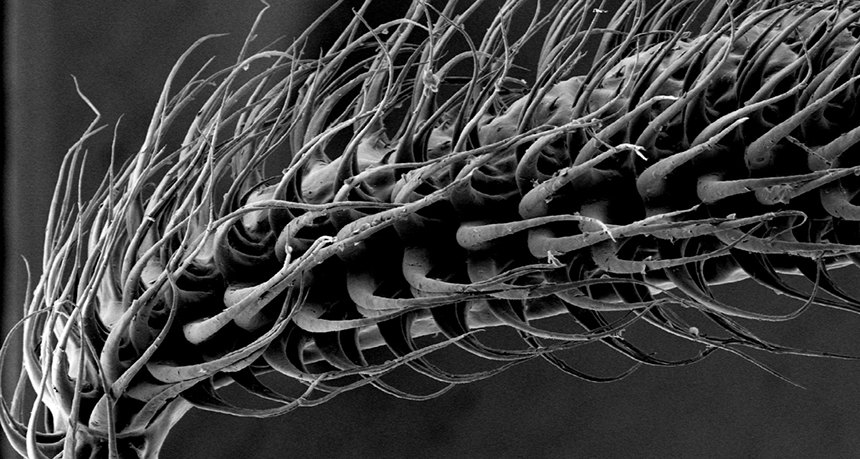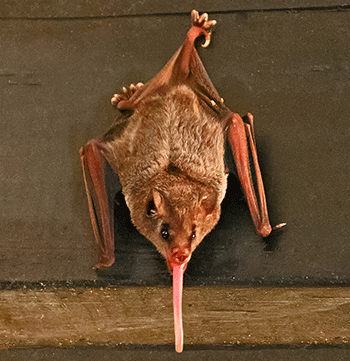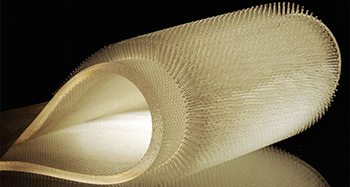The secrets of super-slurper bat tongues
Hair-like structures help animals effectively scoop nectar with each dip

Hair-like structures on the tip of some bats’ tongues help them slurp nectar far more efficiently than a smooth tongue would. Here these structures are shown up close.
Cally Harper/Brainerd-Swartz Laboratory at Brown University
By Sid Perkins
The tongue is a wonderfully versatile muscle. It helps you speak, taste food and swallow. Animals’ tongues have many important jobs too. For instance, while people may use their tongue to lick a lollipop, hummingbirds and some bats use theirs to slurp up a flower’s sweet, sticky nectar. And those who do it best can get a big assist from tongues that are basically hairy, new data show.
One such animal is the Pallas’ long-tongued bat, or Glossophaga soricina (Gla-SOFF-uh-guh Sor-ih-SEE-nuh). Its tongue is long — longer than its entire head! That allows it to reach deeply into tube-like flowers. But that tongue is extraordinary in another way, too. Its tip is covered with long, hair-like structures, observes Alice Nasto. She works at the Massachusetts Institute of Technology in Cambridge. As a mechanical engineer, she designs, develops, builds and tests mechanical devices.

Nasto has studied hairy structures before. In 2016, she worked with a team to study how hairy surfaces trap air bubbles when they’re dipped into liquids. This time, she wanted to learn more about their ability to trap liquids. The tongues of some bats are idea natural examples, she notes.
Previously, researchers who studied these bats’ had described their tongues as “nectar mops,” observes Nasto. But that’s only partly right, she says. Those stringy structures on their tongues don’t absorb nectar as a cloth mop absorbs water. Instead, they increase the tongue’s surface area. That ups the area available for the nectar to stick to. But those hairs pop up only as needed. Most of the time they lay fairly flat. It’s when the bat extends its tongue to slurp nectar that these “hairs” fill with blood and stand up.
But were the super-slurping tongues on these bats as effective as they could be? Nasto and her colleagues wanted to analyze them to find out. And to do that, they needed to turn to math.
Modeling the hairy tongue
The researchers started by building a model of the hairy tongue. They used lasers to sculpt a mold of the shape. The surface needed to be covered with stiff, stubby structures. So the laser had to cut hundreds of tubular holes into the mold. Then the researchers poured in a liquid, rubber-like silicone. This filled the holes and flowed over the top to form a thin sheet. Once the material gelled into a solid, the researchers peeled off the sheet. It was now covered in little stubs.

Next, Nasto’s team dipped the stubby surface into a basin filled with a thick oil. They did this slowly, to make sure no air got trapped between the silicone stubs. As they pulled the fake tongue material out of the oil, they measured how quickly the fluid drained off of it. For a bat, slower drainage means more nectar will stay on long enough to reach its mouth (and tummy).
The team made four surfaces with different stub sizes. The largest stubs were about 4.2 millimeters across (about 1/6 of an inch). The smallest were just 0.2 millimeters across. That span is about eight thousandths of an inch, or about as thick as two sheets of copy paper.
The researchers tested those surfaces with several oils, each having a different viscosity (Vis-KOSS-ih-tee). A fluid’s viscosity is a measure of its resistance to flow. Molasses is very viscous, so it flows slowly. Water is not viscous, so it flows relatively quickly. Some oils the team tested were as viscous as honey. Others were as quick-flowing as motor oil.
Many combinations of surfaces and oils were put to the test. Then the researchers compared how stub size and oil viscosity affected how quickly the fluid drained off of the model “tongue.” Afterward, they used math to describe those relationships with numbers.
The math behind the nectar-lapping ability of a hairy tongue is complicated, Nasto notes. When tongue hairs are closer together, liquid doesn’t drip off of them very quickly. That means more nectar per slurp — but only up to a point. When the structures get too close, there’s less room in between the hairs for nectar to fit.
So, math showed there is an ideal size and spacing for tiny structures on a tongue. And that ideal combination also depends on the thickness of the fluid it would be lapping up.
Nasto’s team used its mathematical model to estimate the best size and spacing for a bat tongue to lap up the most nectar. And the hairy nectar slurper on the Pallas’ long-tongued bat is nearly perfect, they found. In fact, the team estimates, each slurp with its scoops about 10 times as much nectar as if it would if the tongue were smooth.
The researchers describe their findings in the February Physical Review Fluids.
The team’s study “provides nice insight into how liquid gets loaded onto a hairy tongue,” says Elizabeth Brainerd. She works at Brown University in Providence, R.I. As someone who studies biomechanics, she looks into how living things move and function. Brainerd was not part of this research team, but she has studied the tongues of these bats. And their hairy structures don’t seem to be oddly shaped taste buds, she notes. That suggests they instead serve some physical role, such as boosting nectar-lapping.
This bat can dip its tongue into a flower about eight times per second, Brainerd notes. And each dip gleans nearly the maximum amount of nectar possible. That’s good evidence, she adds, that evolution has fine-tuned the size and shape of this animal’s tongue to do the best job it can.







